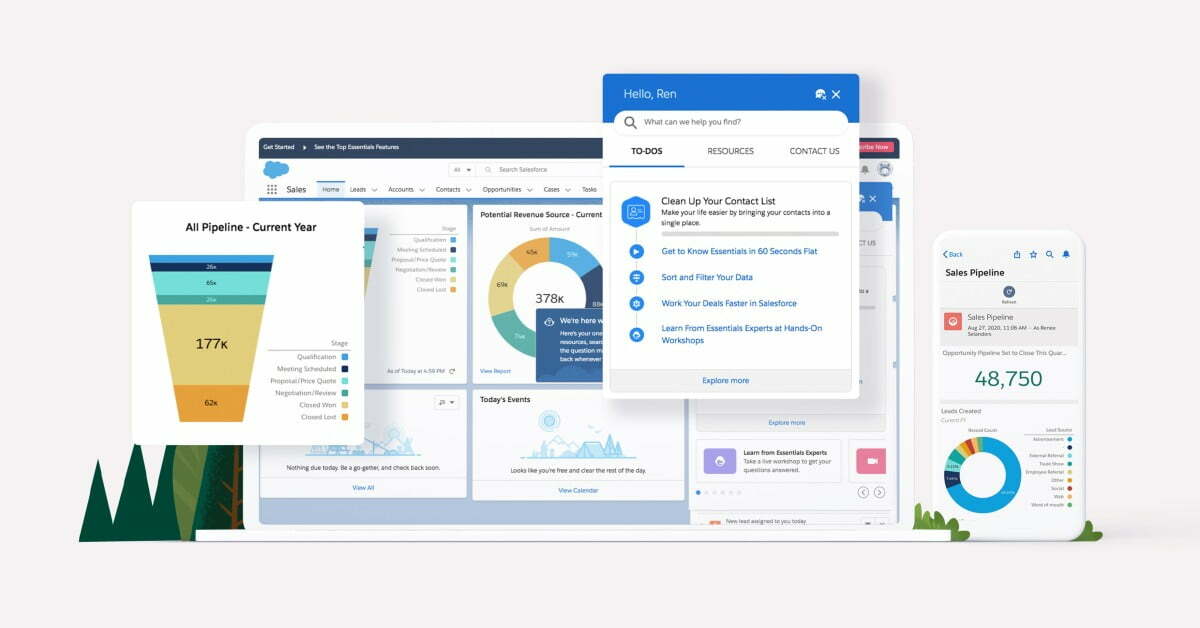| Image Credit: Salesforce
Customer Relationship Management (CRM), the name alone tells everything that is there to know about this acronym widely used in the business vertical. CRM includes all the strategies, activities, and techniques used by companies to manage their interaction with both current and future customers.
If a customer is king then CRM helps companies build a relationship with that king. As a tool, CRM offers a simplified user interface accruing data from different touchpoints that help businesses recognise and communicate with their customers. As Salesforce says in its CRM handbook, “there’s no secret formula” with a CRM application.
These are the women in science of the Amsterdam startup ecosystem.
CRM: what is it and why do you need it?
A CRM application is how businesses manage most of their critical customer information, allowing you to see all the information in one place. Without ever leaving the application, CRM allows businesses to view contact info, follow up with a customer via email or social media, manage tasks, and even track performance.
A number of businesses have witnessed an increase in sales efficiency with the implementation of the right CRM software. A seller-to-customer relationship, in its early stage, can essentially be tracked on an excel sheet or in the form of notes. However, as the business grows and touchpoints of information grow, the old ways of jotting down notes won’t work.
Signs that indicate you are ready for CRM
The very first sign to indicate that you need a CRM is when your sales team lacks a single view of every customer’s contact info, orders, and interactions. The old school way of managing customers could result in little or no visibility. By tracking customers’ details on a spreadsheet or handwritten notes also makes it difficult to generate reports. This makes it difficult to analyse the sales team’s monthly progress.
The pandemic has shown another reason why businesses need customer relationship management. As companies began to close their offices and sales representatives began to work from their homes, there was a new need for businesses to properly store all the customer information. As a mobile solution, CRM eliminates this by capturing data from different sources and allowing you to securely store all the information, whether you work from home, office or an airport cafe.
CRM not only benefits businesses to maintain good communication with customers but also helps customers indirectly. With software like CRM, the customers are not differentiated based on their value to the company. The program pushes the same offers and information to all customers and prospects, regardless of their phase or region.
Lastly, customer relationship management helps businesses be relieved that their communication with customers will scale as they grow from 20 to 200 to 200,000 customers. A CRM is designed with scalability at its core and allows businesses to grow without worrying whether the software will keep with the growth.
How CRM can boost productivity and sales
The third edition of Salesforce’s Small and Medium Business Trends Report shows that “lack of time” is the main constraint for SME decision-makers. This constraint brings out the old paradigm that time literally means money and it is imperative that sales professionals use their time both effectively and efficiently.
For small businesses to grow rapidly, it is important that these businesses arm their sales representatives with the info they need to close deals more quickly. With a CRM application, sales representatives get access to this valuable information, thereby reducing the time spent per deal.
A CRM application also helps a small business sales team to store the data on prospects to ensure that relevant information is available during each interaction. The application also provides sales representatives with metrics related to visibility and forecasting. Thus, a CRM application makes the sales pipeline more efficient and effective.
Sales representatives also need time to sell and with the right CRM at their disposal, they can function in such a way that the entire team is on the same page at all times. A CRM application syncs with mobile devices anywhere, anytime via the cloud and helps salespeople with the right information.
Another way CRM helps increase productivity and sales prospects is by offering better intelligence. Salesforce offers a CRM solution that is made better using artificial intelligence (AI). As a result, the CRM captures real-time signals, whether it is a customer’s support request or a new tweet from a prospective buyer.
A CRM application is further able to analyse every data point pulled from different touchpoints and offers a complete view for each customer. By integrating AI and CRM, Salesforce says small business sales teams get ” automated customer reports, efficient data capture, and even a prediction of future customer behaviour.”
Getting a 360-degree view of every customer
While CRM is capable of transforming the way sales representatives got access to customer information, it is equally important to understand about collecting customer data. The CRM handbook from Salesforce shows that the application collects valuable customer data including client history, current client preferences, client social media presence, client infrastructure details, and past sales interactions.
However, to get a holistic view of your customer and capture data from all sources, the sales team should not forget to think mobile. While considering CRM tools, a small business organisation should look for one that offers functional mobile tools and is capable of enhancing a sales team, which is no longer confined to 8 hours at the desk.
A guide to effective CRM Strategy
In order to build an effective CRM strategy, you will need to follow these seven basic steps
- Vision: For an effective CRM strategy, sales leaders should first define a clear vision, one that is repeatable and action-oriented. It can be anything from becoming a market leader to redefining customer service but the vision should be a rallying cry for the team and should result in impact across the organisation.
- Strategy: The strategy should define how you can achieve your vision. A strategy can lay the path for reaching your goal whether it is by competing on a parameter like price or by offering innovative and different products.
- Business objectives: A business objective is essentially a roadmap for how your vision and strategy translates into day-to-day work. Ideally, a CRM system should be implemented by reviewing old inefficiencies and optimising new techniques.
- Executive sponsorship: Salesforce says it is critical to get every team member on board for implementing an effective CRM strategy. A lack of executive sponsorship is cited as one of the top five factors for CRM failure.
- Metrics: Metrics should be visible to everyone and small businesses should engage in creating dashboards for all levels of the organisation. Whether you are a sales representative, a manager, or in the executive team, metrics should be well defined and clear to every member.
- Priorities: It is important to decide what is your most important deliverable and Salesforce recommends training as the top priority.
- Roadmap: Once these phases are done, a CRM system should be implemented as a way to enhance and add new features down the road. This is only possible if businesses define their roadmap well in advance.
CRM: how to maximise ROI
Once you decide to implement a CRM solution, one of the immediate focuses would be to get maximum return on investment. There are a number of ways for you to maximise your return on investment after implementing a CRM system. Here is a look at some of the most prominent steps that one should take.
The first is to choose a cloud-based CRM solution since it eliminates the demand for an on-premise CRM application like servers, software issues, and new version upgrades. The second is to integrate your CRM with applications that provide value, be it a business application or a social application.
The next step is to consider mobile integration to get maximum benefits from a CRM application. While CRM is a great tool for salespeople, it can also be effectively used by marketing teams if both departments work together.
Last but the most important way to maximise ROI from a CRM application is by building relationships with customers. CRM applications allow salespeople to connect with customers and build relationships that grow over time. However, as customers evolve and change, sales people must also change with them and use CRM data to bring about that change.
Want to find out what CRM can do for your business? Read the CRM handbook that explains how to make a success of your first steps with CRM. You’ll find all the information you need on how to build your CRM strategy, how to maximise your ROI and how to improve your sales and productivity.
How partnering up with Salesforce helped him succeed!









